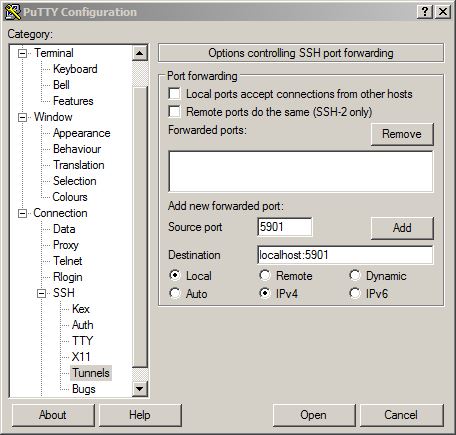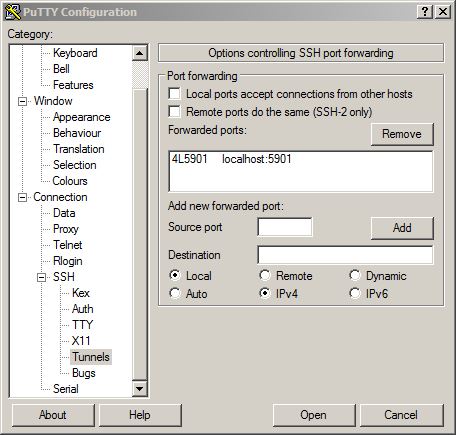What is VNC?
VNC (Virtual Network Computing) is a software to show the graphical output of applications on a remote machine (server) locally on a client machine. Client and server interact over the Remote Framebuffer (RFB) Protocol. Technically the vncserver process is an X-Server with a virtual display attached to it.
How do I use VNC?
VNC inside the ETH network
Start a vnc-server on the machine you want to control, with vncserver :1 (:1 means display, resp. port 1). You will be asked to define a password for accessing your server and another one for just observing without interacting. After that, your server is up and running and you can connect to it with any available VNC-clients (e.g. TightVNC) by entering the hostname you want to connect to, like hostname:1.
VNC access from the internet
Due to security reasons the listening port of the vnc server is not directly reachable from a client in the internet. There are two possibilities to perform a vnc session to an ETH network internal host from the internet :
- Use the Cisco SSL-VPN client software of ID and connect the SSL-VPN adapter before starting the VNC viewer programm
- Access the VNC-server through an SSH-tunnel
VNC through SSH tunnel with Linux
- Start VNC Server on remote host with the option -localhost
$ ssh <remoteHost> // where <remoteHost> is the machine on which the application you want to start runs $ vncserver :<display#> -localhost // where <display#> is a number between 1 and 20
Attention! Always choose a strong password when starting vncserver. Otherwise, you'll make it trivial for intruders to hijack your account!
- Start VNC viewer on your machine (Linux)
$ vncviewer -via <remotehost>.ee.ethz.ch localhost:<display#>
Mac users may establish the tunnel via SSH, then use "open vnc://localhost:PORT" to use the built-in VNC client.
VNC through SSH tunnel with Windows
Start VNC viewer on your machine (Windows with TightVNC and putty)
Putty is the most popular free ssh client software on Windows. When you have configured a normal ssh session to the vnc server machine you can configure additional port forwards on the established ssh-connection. A tunnel configuration needs a local listening port and a destination on ssh server side.The destination could be localhost or another machine reachable by the ssh server machine.
The following screeshots show how to configure an additional tunnel for connecting the local vnc-server on port 5901 of the ssh server machine:

After clicking the "Add"-Button the putty window changes to:

Don't forget to save the session if you want this tunnel to be permanently configured in this session.
Now you can connect your vnc viewer programm to the configured listening port of the putty client on the client machine:

Ending a VNC Session
![]() Warning! Do not log out via the logout menu of the Operating System within the VNC session!
Warning! Do not log out via the logout menu of the Operating System within the VNC session!
This causes a dead VNC connection. Dead means, you can't connect to that display anymore, which results in an unusuable, ressource consuming VNC server process on the host side.
Finally, after you have closed the VNC-Window on your machine, it's important to end the vnc process on the remote host to avoid unused processes:
$ ssh <remoteHost> $ vncserver -kill :<display#>
Or You add the 'vncserver -kill' command directly in your 'xstartup' script as shown in 'Troubleshooting' Pt.2 below.
Troubleshooting
If you are using gnome as default desktop environment and are affected by completely wrong keyboard-layout after logon to gnome (http://bugs.debian.org/476727) use the following workaround:
Directly in the line before /etc/X11/Xsession of $HOME/.vnc/xstartup add the line
export XKL_XMODMAP_DISABLE=1
- If you still want to use gnome2 or xfce instead of gnome3 change following:
#!/bin/sh xrdb $HOME/.Xresources xsetroot -solid grey export XKL_XMODMAP_DISABLE=1 /usr/bin/gnome-session-fallback #/etc/X11/Xsession #/usr/bin/wmaker #/usr/bin/startkde # Automatically end the server process after leaving vncserver -kill $DISPLAYIn this case with gnome-session-falllback please make sure to check next point with the keyboard changes. Point 3
If you are using gnome as default desktop environment and the up and down arrows behave wrong (http://bugs.debian.org/cgi-bin/bugreport.cgi?bug=679543) do the following:
Go to: Applications->System Tools->Preferences->System Settings->Keyboard->Shortcuts->Windows
- And disable options: "Toggle maximization state" and "Restore windows"